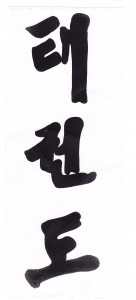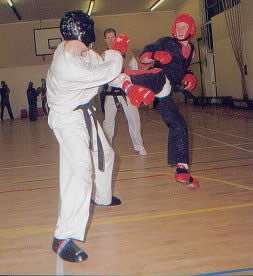A Beginner’s Guide to Taekwondo
Taekwondo, renowned for it’s dynamic kicking, as we know it today has two distinct styles. ITF (International Taekwondo Federation) which was founded by Korean General Choi Hong Hi and incorporates Patterns (Tul) which apart from a wide range of kicks, has various stances, blocking and punching techniques, as well as a wide variety of strikes with elbows, knife hands and thrusts. WTF (World Taekwondo Federation) which is the branch of Taekwondo practised in the Olympic games, has a big emphasis on kicking, in particular of the spinning and step turning variety. Another striking difference is the ITF patterns are performed in a lower set of stances than those of the WTF. My background was ITF but I have studied WTF Taekwondo too.
from a wide range of kicks, has various stances, blocking and punching techniques, as well as a wide variety of strikes with elbows, knife hands and thrusts. WTF (World Taekwondo Federation) which is the branch of Taekwondo practised in the Olympic games, has a big emphasis on kicking, in particular of the spinning and step turning variety. Another striking difference is the ITF patterns are performed in a lower set of stances than those of the WTF. My background was ITF but I have studied WTF Taekwondo too.
Taekwondo if kept to how it was originally developed, is a traditional martial art. There are may traditions for example, in Korean culture, the higher class wore white with black trimming around the edges of their garments. In keeping with this historic tradition, all ITF style Taekwondo practitioners wear white dobuks (White uniforms) and black piping around the edges of the jacket. 4th Degree and above wear an additional stripe down the side of the leg of the trousers. WTF style Black Belts do not wear this piping, instead wearing mostly an all white dobuk, with a black collar. Other traditions include learning Korean theory and the historical meanings of the patterns (Tuls/Hyungs/Poomsae). You will find most of this information on general Taekwondo websites.
 Names and historic symbolism are incorporated into all aspects of traditional taekwondo, particularly the study of patterns, and there is a strong element of Korean culture and religious philosophy. Today, the Kukkiwon, or World Taekwondo Headquarters is the WTF center for Taekwondo. WTF Taekwondo could be classified as “Sport taekwondo” but many people of all ages find both styles of Taekwondo a beautiful martial art to watch and practice.
Names and historic symbolism are incorporated into all aspects of traditional taekwondo, particularly the study of patterns, and there is a strong element of Korean culture and religious philosophy. Today, the Kukkiwon, or World Taekwondo Headquarters is the WTF center for Taekwondo. WTF Taekwondo could be classified as “Sport taekwondo” but many people of all ages find both styles of Taekwondo a beautiful martial art to watch and practice.
Taekwondo is a relatively young art when you compare it to other martial arts like Karate or Chinese Kung Fu. Taekwondo was born in 1955, the culmination of Taekkyeon (the ancient Korean art of Foot Fighting) and Karate (which originated from Chinese Kung Fu).Taekkyeon was first documented in 1790 and the origins of Karate date back as far as 1392. All these arts had patterns or forms, a series of movements which had the purpose of imaginary practice against opponents, with a set purpose such as releasing or nerve-striking a particular area of the body in lethal combat. If you look deeply into the moves and their origins, many represent applications to pressure points or complicated arm and wrist locks. There could even be several applications to one movement. This is the study of pattern or form application. After Taekwondo was founded by General Choi Hong Hi, and developed in the military, it quickly spread to various civilian organisations, such as schools and universities.
Many people enjoy the practice of patterns: They are a form of mental test, because they can be hard to learn and take discipline to master. They develop focus, balance and co-ordination. Done rhythmically, with good breath control, they can be a reasonable aerobic work-out. Patterns give structure to the Taekwondo Syllabus, which is particularly important for children. The first patterns teach you the basic techniques so they introduce you to the basic stances, strike, kicks and blocks. Some claim that it helps children develop concentration so their school work improves.
Whatever the reason, people all over the world practice them for their own reasons. For some, it could even be a form of meditation, taking them away from the hustle and bustle of everyday life. Others just simply enjoy the feeling of the practice, like a dance, it is an art. And a well performed pattern is always a joy to watch. It is very personal, and each instructor will have their own slant on how they view patterns and how they should be taught or in some cases, not taught at all. In 1993 I produced a patterns dvd to help beginner’s to black belt. It is an excellent learning too for the beginner because it is simple, straight to the point and very clear. It goes through the ITF patterns in a step by step manner and can be purchased in the shop on this website.
OTHER ELEMENTS OF TAEKWONDO
LINEWORK
This involves practicing the basic Taekwondo techniques up and down the hall in lines, hence the term linework. This helps with practicing basic stances, blocks, strikes, kicks and requires balance timing and co-ordination. Below is a lesson on basic commonly taught linework.
STEP SPARRING
Step Sparring may include 3-, 2- and 1-step sparring, and these are learnt as some of the preparatory skills to free sparring and self-defense. They develop co-ordination, distance and reaction time.
COMPETITIVE SPARRING
 Competition Taekwondo is a game of strategy to outwit the opponent.The purpose of competitive sparring is to defeat the opponent through analysis of the situation, judgment of the available options and immediate execution of the most appropriate action to score points in the match. Strategy is used to score points against the opponent whilst moving efficiently and effectively.
Competition Taekwondo is a game of strategy to outwit the opponent.The purpose of competitive sparring is to defeat the opponent through analysis of the situation, judgment of the available options and immediate execution of the most appropriate action to score points in the match. Strategy is used to score points against the opponent whilst moving efficiently and effectively.
To execute an effective sparring, a fighter must be thoroughly familiar with the rules and regulations of the game, as well as the strategies to score points which are learnt in a step by step manner as you progress through the ranks of the art. You need to master the fundamental skills and practice them in every situation. Once you have mastered basic skills you can then combine them together to practice pre-arranged sparring, point-stop sparring, and eventually continuous free sparring. At a higher level, the fighter must rely on his/her coach to evaluate the opponent and formulate strategy based on this evaluation.
Having been a world class competitor in the past (see Bio) and training high level teams for events like the ‘Clash of the Titans’, I spent alot of time studying and coaching competitive fighters. This is an in depth study and I try to share some of this knowledge in my seminars.
TAEKWONDO BREAKING OR DESTRUCTION
 One of my favourite areas of expertise was destruction during my competitive Taekwondo years. Technique and power is required to break materials from wood to tiles and building blocks. I have shared some of my knowledge about breaking in this article.
One of my favourite areas of expertise was destruction during my competitive Taekwondo years. Technique and power is required to break materials from wood to tiles and building blocks. I have shared some of my knowledge about breaking in this article.
Master Frank Murphy 7th Dan has been practicing Taekwon-Do since 1974.




